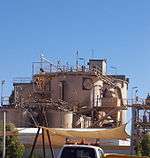Challenger mine
|
The plant at the minesite | |
| Location | |
|---|---|
 Challenger Gold Mine Location in Australia | |
| State | South Australia |
| Country | Australia |
| Coordinates | 29°52′36″S 133°35′11″E / 29.8767828662°S 133.586496796°ECoordinates: 29°52′36″S 133°35′11″E / 29.8767828662°S 133.586496796°E |
| Production | |
| Production | 66,216 |
| Financial year | 2012-13 |
| History | |
| Opened | 2002 |
| Owner | |
| Company | Kingsgate Consolidated Limited |
| Website | Kingsgate Consolidated Limited |
| Year of acquisition | 2011 |
The Challenger mine is a gold mine in the Far North of South Australia, 165 km west of the Stuart Highway and 740 km north-west of Adelaide. It is operated by Kingsgate Consolidated Ltd.
History
The ore body was first discovered in 1995. The mine was initially an open pit commenced in 2002 and converted to underground mining in 2005.
The mine had an estimated reserve of 512,000 ounces of gold from a resource of 1 million ounces of gold at June 2007, this was revised in September 2013 to a resource of 102,000 ounces of gold due to operations and a further understanding of the underlying geology.[1]
Byrnecut Mining Australia is the underground mining contractor.
Nature of Facility
Challenger Gold Mine is an underground gold mine and processing facility. The infrastructure covers an area of approximately 300 hectares (740 acres) and includes the processing plant, a mine village housing up to 140 personnel working a fly-in /fly-out roster, aerodrome, reagent and fuel storage facilities, offices, workshops, a laboratory, ancillary buildings and haul roads. Water is supplied from a process water bore field located approximately 3 kilometres (2 mi) west of Challenger. A diesel power station (PS1), supplies power to the treatment plant, and village. A secondary diesel power station (PS2) supplies power to the underground mine and surface ventilation fan.
The mine lease is located in the Far North of South Australia, 750 kilometres (470 mi) north-west of Adelaide within the Woomera Prohibited Area on the Jumbuck Pastoral Company lease. The site is either accessed by a nine-hour drive along sealed and unsealed roads or by Air which takes approximately 1.5 hours by plane from Adelaide. The main access road is a private road and runs approximately 170 kilometres (110 mi) west from the Stuart Highway
Production
Production figures of the recent past were:[2]
| Year | Production | Grade | Cost per ounce |
| 2005-06 | 108,080 ounces | 9.52 g/t | A$280 |
| 2006-07 | 108,191 ounces | 9.66 g/t | A$309 |
| 2007-08 | 109,326 ounces | 8.35 g/t | A$367 |
| 2008-09 | 98,755 ounces | 7.54 g/t | A$438 |
| 2009-10 [3] | 80,570 ounces | 5.0 g/t | A$697 |
| 2010-11 | 96,645 ounces | 4.3 g/t | A$786 |
| 2011-12 | 87,388 ounces | 4.6 g/t | A$1,397 |
| 2012-13 | 66,216 ounces | 3.9 g/t | US$2,030 |
| 2013-14 [4] | 74,954 ounces | 4.8 g/t | US$1,504 |
References
- ↑ Challenger 2013 Mineral Resources & Ore Reserves Update Archived November 13, 2014, at the Wayback Machine. Kingsgate Website, accessed: 13 November 2014
- ↑ Challenger: Production Archived September 8, 2010, at the Wayback Machine. Dominion website, accessed: 27 July 2010
- ↑ Quarterly report June 2010 Dominion ASX announcement, published: 29 July 2010, accessed: 31 July 2010
- ↑ Annual Report 2014 Archived November 13, 2014, at the Wayback Machine. Kingsgate Annual report 2014, published: 23 October 2014, accessed: 13 November 2014
